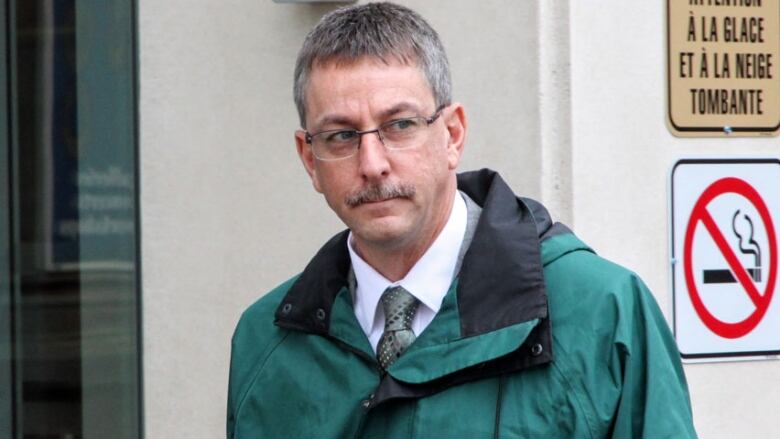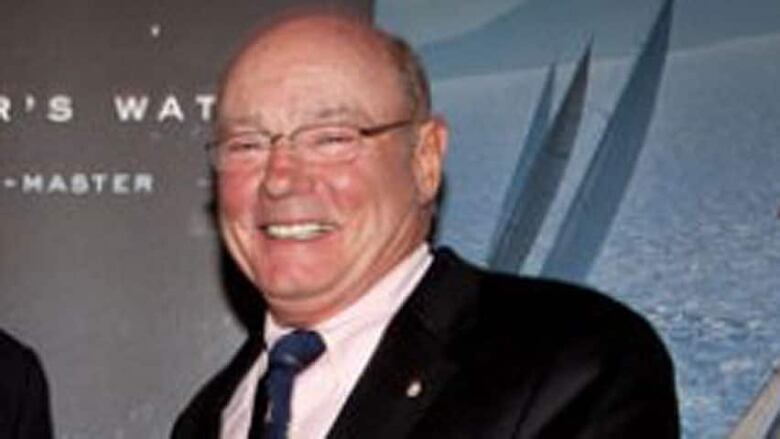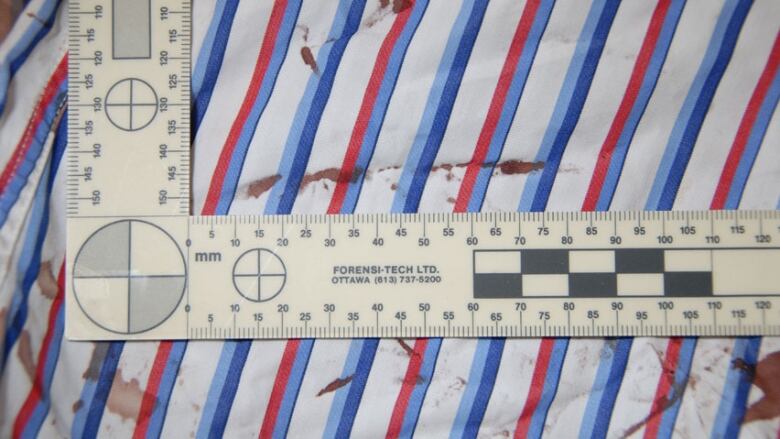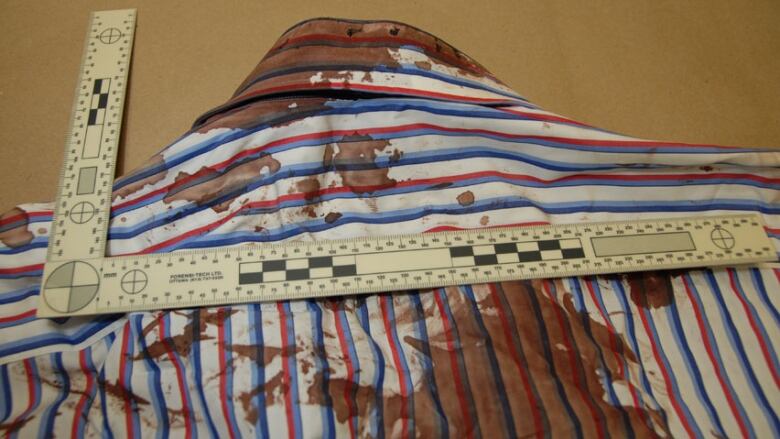Dennis Oland murder trial hears about 5 stained areas found on his jacket
Crown has previously said 4 areas of blood found on seized brown jacket matched DNA profile of Richard Oland
RCMP Sgt. Brian Wentzell, a blood spatter expert, testified about the five areas of staining he found on the jacket.
The stains were inthe upper left chest area and on both sleeves, said Wentzell.
They ranged in size from "sub-millimetre" to about two centimetres, he said.
All five stains were visible without using any special enhancements, just a strong light and magnification,but they "varied in concentrations" and some were "quite faint,"said Wentzell.
"Because of the colour of the jacket, they don't show up very well," he added.

"DNA scientists will testify that in each of those locations, a DNAprofile was found It matched that of Richard Oland," Veniot had said.
The prominent businessman's body was discovered lying face down in a large pool of bloodin his uptown Saint John office on July 7, 2011.
He had suffered 45 sharp and blunt force injuries to his head, neck and hands.
Dennis Oland, 47, who was the last known person to see his father alive during a meeting at his investment firm office the night before, has pleaded not guilty in his death.

Wentzell, who was asked by the Saint John Police Force to assist in the investigation, had testified Thursday that his abilities were "limited"by the amount of time that had passed before he was called.
Heonly arrived at the crime scene on July 11, 2011 four days after Oland's body was discovered. By then, the body had already been removed, several people had been in and out of the office,and some items had been moved.
Veniot revisited the issue with Wentzell on Friday, asking if he had examined other homicide scenes where the body was not present.
He replied that he had. Wentzell added that he has even, on occasion, offered blood spatter analysis based on photos alone, without attending a crime scene.
Wentzellspent more than eight hours examining the large blood pool and "hundreds" of blood spatter stains inRichardOland's office.
Jacket examined 5 months after seizure
He was sent Dennis Oland'sjacket to examine on Nov. 30, 2011 nearly five months later.
"I was to determine if I could locate what stains were on the jacket and how they were deposited on the jacket," he said.
He examined the jacketon Dec. 6, 2011, marking the stains he found and photographing them.

The front of the right sleeve had astain "three millimetresor less in size," he said, showing a photo ofthe stain, which had been magnified 20 times.
"Red staining is noted in the fibres," he said, adding there wasno garment manufacturer's tag to indicate what the jacket was made of.
A second stain was found on the front of the right sleeve, also measuring "three millimetresor less in size."
The third "reddishstaining" of similar size was in the upper left chest area.
The inside front of the right sleeve had a"minimum of twostains, sub-millimetrein size," and "three areas of diluted-appearing stains, two centimetresor less in size," said Wentzell.

On the inside cuff of the left sleeve, Wentzell found a "minimum of four stains, sub-millimetre in size" and two stains measuring one millimetre by five millimetres, and one millimetre by three millimetres.
After marking and photographing the jacket, Wentzell requested the marked areas be tested for blood and DNA by another RCMPlab.
Another witness is expected to testify about those findings later in the trial.
Wentzell examined the jacket again on Oct. 30, 2012. "There was going to be additional sampling and I wanted to record what had been sampled at that point," he said.
He took photographs of the jacket, showing where fabric in the areas he had previously marked, had been removed for testing.
He also checked the jacket again for any additional stains, but didn't find any, he said.
Indentation, pattern found onvictim's clothing
Wentzell also examined Richard Oland's clothing and found a linearindentation mark on his blood-saturated sweater.

A similarlinear transfer stain was also located on the front right side of the victim's blood-soaked shirt.
Below the back of the collar, which had "hundreds" of blood spatter stains on it, Wentzell found a transfer stain "indicating some kind of pattern detail."
"I'm not able to say what that was," he said.

Sgt. Mark Smith, the head of the Saint John Police Force's forensic identification unit, previously testified that the bluntforce woundsmeasured about three centimetres in diameter and appeared to have been caused by a hammer-type instrument.
He estimated the incised wounds were made by a sharp instrument about six or seven centimetres in length.
No weapon was ever found.
The victim's loafer-style leather shoes also had some stains. The left one, for example, had twospatter stains on theoutstep side near the heel, and a minimum of three on top of the shoe in thetoe area of the instep side, saidWentzell.
The location and shape of those stains suggest they were deposited while the shoe was sole-down on the floor.
Cross-examination set for Monday
Dennis Oland's defence lawyers are scheduled to cross-examine Wentzell on Monday morning.
They have previously suggested Richard Oland's blood may have been transferred to the jacket.
They presented evidence about the victim having a skin condition that would sometimes make his scalp bleed.
They also presented evidencethat he had a hearing problem and would often lean in when speaking to someone, sometimes touching their arms as he spoke.
The Crown asked the pathologist if he notedany open sores on Oland's head that were unrelated to the attack. Dr. Ather Naseemuddin said he did not recall seeing any.
Before dismissing the jurorsfor the weekend Justice John Walsh reminded them "the time to decide this case is after not before you've heard all the evidence."
He also urged them to "avoid the media."












_(720p).jpg)


 OFFICIAL HD MUSIC VIDEO.jpg)
.jpg)



























































































